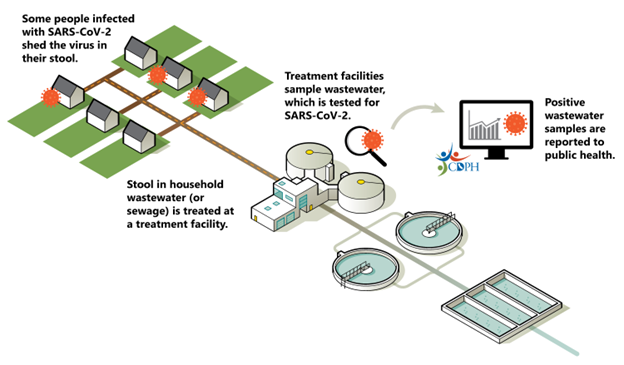Pardon Our Progress! We’re working hard to improve our website. Some information may not be the most current during this process. Please use the contact information on the website for assistance.
Page Content
Wastewater Monitoring
What is wastewater monitoring?
- Wastewater monitoring (WWM) is the testing of sewage for viruses, bacteria, toxins, or other substances that can be shed into wastewater via toilets, sinks, showers, laundry, and drains.
- Through funding provided by the
CDC’s National Wastewater Surveillance System (NWSS), the Alaska Division of Public Health is developing WWM infrastructure in many Alaska communities.
- The following figure provides a basic overview of how WWM occurs in communities:

Image courtesy of the California Department of Public Health |
Wastewater monitoring overview (text-only version)
Why do we monitor wastewater?
- WWM is a cost-effective and efficient tool for public health officials to monitor disease trends at the population level, in close to real time.
- It also captures disease information about people in the community who either do not have access to healthcare or are not seeking healthcare.
- Moreover, it can be used to pinpoint specific areas or communities with higher levels of pathogen shedding, indicating potential hotspots for disease transmission; assess effectiveness of interventions; monitor emerging threats; and complement other public health disease monitoring tools.
Where is Alaska wastewater being tested?
- Currently, the bulk of Alaska wastewater testing is occurring through one of two national programs, CDC NWSS and WastewaterSCAN (both are conducted at Verily Labs, a subsidiary of Alphabet, Inc.).
NWSS is a federal collaborative effort involving Verily Inc. and government agencies to establish a nationwide surveillance network for monitoring infectious diseases in wastewater. WastewaterSCAN is a private company specializing in wastewater monitoring technology that offers a broader scope of testing options than NWSS.
- Testing in Bethel is occurring through the Yukon-Kuskokwim Health Corporation's Office of Environmental Health.
- In the near future, additional testing will occur at two primary testing locations: the University of Alaska Anchorage’s
AIMS Core Facility and the Department of Environmental Conservation’s
Environmental Health Laboratory.
- Capacity to conduct whole genome sequencing for wastewater samples is currently being developed through partnerships formed with CDC’s
Arctic Investigations Program, the University of Alaska Fairbanks, and the
Alaska State Public Health Laboratories.
Which Alaska communities are currently participating in WWM?
What are the communities testing for?
- Most communities that are currently doing WWM are testing for SARS-CoV-2 with plans to expand to other respiratory infectious pathogens such as influenza and respiratory syncytial virus (RSV).
- The WastewaterSCAN program, in which Anchorage is the only current participating community, provides surveillance for additional disease pathogens such as enterics, hepatitis A, and mpox.
- DPH is examining the feasibility of a testing program for multidrug-resistant organisms such as
Candida auris and carbapenemase-producing organisms.
Challenges of WWM include the following:
- Exclusion of communities and/or houses that are not on a sewer system, such as those on septic-based systems.
- Potential exclusion of communities, facilities, and homes that operate on a decentralized wastewater system (e.g., prisons, universities, or some hospitals).
- Limitations of the laboratory’s ability to detect low levels of a pathogen within a wastewater sample.
- Resource constraints.
Questions?
Please contact
Clayton Weingartner and/or
William George with any questions about WWM, including how to get a program started in your community.
References